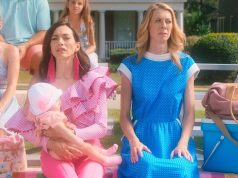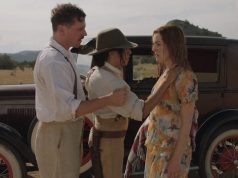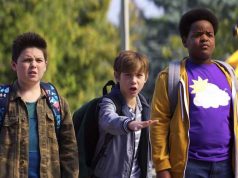Jason Voorhees, Michael Myers and Freddy Krueger were so successful in their killing sprees that they were bound to inspire copycats. And sure enough, the town of Glen Echo is about to meet its worst nightmare: Leslie Vernon?
We meet Leslie Vernon (Nathan Baesel) as a 30-year-old, goofy and fun, the kind of guy who plays Xbox and smokes pot and probably made fun of frat boys when he was in college. He says that when he was a kid, the town suspected him of being evil and cast him into a waterfall to perish. Now, 20 years later, he’s an affable, likable guy who happens to be preparing a horrific revenge.
In “Behind the Mask: The Rise of Leslie Vernon,” a razor-sharp deconstruction of slasher films, he is the subject of a documentary being made by a grad student named Taylor (Angela Goethals) and her two cameramen, Todd (Britain Spellings) and Doug (Ben Pace). Leslie has allowed them to follow him in his preparations, and has even granted them unprecedented access on the night he actually embarks on his murderous rampage.
Taylor and the others probably don’t think he’ll really go through with it; they think he’s a nut. But they get a little nervous when he takes them to meet his mentor, Eugene (Scott Wilson), a retired psycho killer from the old days. He admires the work of these young kids like Jason and Freddy, who can kill for years on end and keep coming back from the dead. Why, in his day, a killer would attack one slumber party, wipe everyone out, and that was it! There were no sequels back then.
The first hour of the film is told through the lens of Taylor’s cameramen, documentary-style, as Leslie explains how one goes about setting up a “Friday the 13th”-style massacre. First you gotta create some lore, you see, in the form of an old town legend, and establish a house — maybe the maniac’s childhood home — as a focal point. There’s physical training, too, of course. Leslie does cardio every day, so he can effectively do “that thing of looking like you’re walking while everyone else is running their a**** off.”
Then there’s the matter of victim selection. Every psycho killer focuses on one virginal girl who might be The One — the one who ultimately survives the attack while all her friends are slaughtered. You stalk her a little bit beforehand, make her a little nervous, maybe plant a newspaper story that makes her think her great-uncle was an escaped mental patient, stuff like that.
The genius of “Behind the Mask” is the way it breaks down the elements of movies like “Halloween” and “Nightmare on Elm Street” into logical, practical pieces. Those films are told from the perspective of the victims, of course. By unmasking the killer and showing us his point of view, the logistics of his attacks, the advance preparation required, “Behind the Mask” shows how silly it all is. (How come the victims’ cars won’t start when they try to escape? Because the killer removed the spark plugs, duh. Not so scary anymore, is it?)
And yet there are some decent chills, too, in the film’s last act. Taylor and her crew stop filming, and the movie we’re watching switches from a mockumentary to a traditional style (i.e., where the characters don’t know they’re in a movie). We get to see Leslie’s plan play out as he designed, with some surprises influenced by Taylor’s presence — no longer as an impartial observer with a camera, but as an actual participant.
Writers Scott Glosserman (who also directed) and David J. Stieve have a wonderfully clever idea here, and it’s a treat for fans of slasher movies to see their beloved clichés and plot devices mocked affectionately. Comparable in theme to the “Scream” series, “Behind the Mask” both parodies slasher films and IS a slasher film. As an added treat, it has cameos by Robert “Freddy Krueger” Englund as a psychiatrist determined to stop Leslie (the Donald Pleasence role from the “Halloween” films, basically), and Zelda “the tiny psychic from ‘Poltergeist'” Rubinstein as a creepy librarian. Maybe they just needed the work, but maybe they also saw that “Behind the Mask” was a worthy project, both funny and creepy, just like the best entries in the genre it spoofs.
B+ (1 hr., 30 min.; )





